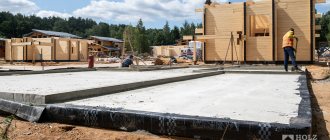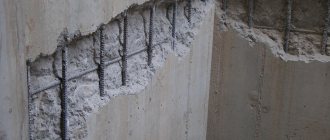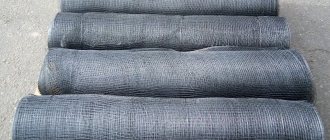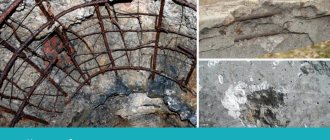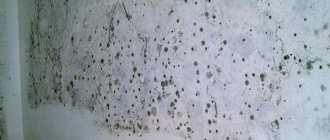Beton-House.com
Website about concrete: construction, characteristics, design. We combine the experience of professionals and private craftsmen in one place
Priming a concrete wall
Priming any surfaces before finishing is an indispensable condition for the installation of reliable and durable coatings. Concrete is no exception.
Let's figure out how important it is to treat concrete bases with a primer, what types of products are used for this, how primers for deep penetration concrete differ from other types, and also consider the technology for applying these compounds.
Functions of primers
Products made from standard concrete are prone to gradual destruction and are susceptible to the influence of natural factors. The primer is largely capable of preventing or slowing down the influence of the external environment.
Possibilities of primer compositions:
- The primer ensures uniformity of the coating, as it penetrates into all, even small, pores. It is easier to apply subsequent finishing materials to a primed surface, including putty, varnish, paint, wallpaper, linoleum, etc.
- Thanks to the primer, a normal level of adhesion (adhesion) between materials is ensured.
- A primer for concrete makes the surface layer of the material stronger. This does not mean that without it the concrete will necessarily fall off in pieces. However, even if the concrete begins to crumble, this will lead to peeling of the finishing materials.
- The soil protects the concrete surface from adverse environmental factors, including humidity, wind, chemicals, mold and mildew.
- The primer composition allows you to save on the consumption of material applied subsequently (glue, varnish, paint, etc.). The reason for the savings is that the primer will fill all the pores and cracks.
- A concrete primer not only prevents the concrete from becoming too wet by acting as a waterproofing agent, but also protects the material from excessive dryness.
Thus, in finishing work, the use of a primer is mandatory. Without priming it is impossible to ensure proper quality of repair.
Why prime concrete?
Any concrete, regardless of brand strength and class, has a porous structure. During the ripening process, moisture, air, and cement mortar may remain in the pores. When the structure is actively used, this can become a source of problems - low density will negatively affect strength, and moisture will seep through the pores.
The finished layer protects the base from the negative effects of operational loads
Modern soils are capable of turning concrete into dense, waterproof stone. Other functions include ensuring a high level of adhesion and reducing the consumption of finishing layers.
As a result, several goals can be achieved:
- ensuring the durability of the structure;
- protection from negative external influences;
- surface hardening, increasing wear resistance;
- strengthening weak concrete;
- reducing the consumption of subsequent finishing layers.
Classification of primers by composition
Below are the characteristics of common types of primer compositions:
- Polystyrene primers. These compositions are rarely used in everyday life. The fact is that such soils include toxic solvents. Polymer compositions are used in industrial premises or for finishing facades. Also, a polystyrene base is necessary for some specific types of paints. Typically, polystyrene primers are applied to plaster - under tiles or paint.
- The most common type of primer is based on an acrylic component. The advantages of acrylic compositions include the absence of a pungent odor, compatibility with any type of finishing materials, and excellent absorbency. As a rule, finishing work can begin within 3-4 hours after processing the concrete. The environmental friendliness of acrylic allows the use of such primers for any premises, including children's rooms. However, it is not advisable to use acrylic for external walls, as it dries too quickly.
- To quickly finish a room, polyvinyl acetate primers are used. They dry within half an hour. After this, to improve adhesion, the surface must be treated with PVA glue.
- Epoxy primers are made from resin. Most often used when working with self-leveling floors. Allows you to significantly increase the wear resistance of the material.
- Alkyd primers are also in demand. They are applied to the concrete surface before painting. Alkyds penetrate the pores and protect concrete from moisture. Surface drying time is approximately 12-15 hours.
Classification of primers
For processing aerated concrete, primers with polymer content are considered the best option. Primers for aerated concrete not only protect the material from moisture, but also strengthen its structure.
Structural acrylic primers
The cost of structural external primers is 920-1700 rubles. Such materials contain quartz particles and are actively used for decorative plasters.
Main technical characteristics:
- type of work: universal, external, internal;
- White color;
- tinting: possible;
- application surface: concrete, plastered concrete;
- gloss level: matte;
- properties: quick-drying primer.
Acrylic primers are diluted with ordinary clean water
Scope of application
Structural primer is used for pre-treatment of concrete, foam concrete, plastered, putty, and water-dispersed concrete before applying decorative plasters.
Peculiarities
Forms a rough structure on smooth concrete, improves adhesion. Materials of this type are presented in white, which evens out the color of the surface and compensates for contrasting color differences in the bases. Structural soil is characterized by high vapor permeability.
Application method
The composition is applied to concrete, cleaned of grease stains, dirt and dust. The base must be dry and durable. If working on previously painted surfaces, peeling layers should be removed. Next, the surface is sanded and freed from abrasive residues.
The soil itself is ready for use, but requires preliminary mixing with a construction mixer. Application is carried out with a brush or roller with short pile. When working outdoors, primer should not be applied during rain, at temperatures below +5 degrees.
Under favorable conditions (air humidity no more than 65%, temperature +20 degrees), the primer dries in 120 minutes. Finishing layers are applied no earlier than after 12 hours. Average consumption is 5 sq.m/l.
Classification of primers according to the quality of the base
Primer compositions are also usually distinguished based on the characteristics of the base, namely: its porosity and level of friability. According to this indicator, primers can belong to one of three groups:
How the primer works
- Deep penetration primer for concrete with increased porosity. Moreover, there are not only many pores in such concrete, they are also deep. Important note: the surface should not be too loose. Deep penetration primers can penetrate approximately 5-7 millimeters deep into the concrete. Such compositions are characterized by increased adhesive capabilities, which is especially important in the presence of deep pores. Good adhesion is achieved thanks to latex particles that bond the concrete surface with the finishing material.
- Impregnating soils are best used to protect old loose concrete (for example, for reconstruction purposes). Impregnations are also relevant for highly porous surfaces. The impregnating composition contains a special binding element that holds all small particles of material together. The most expensive types of impregnations can strengthen walls and screeds that were previously considered beyond repair. In relation to impregnations, the principle applies: the more it is applied, the stronger the concrete structure will be.
- Adhesive primers are designed to create a special invisible film that will provide better adhesion to dissimilar materials. Adhesive compounds are especially relevant for very smooth concrete surfaces that have previously been treated with putty or painted. You can also apply an adhesive primer before plastering if the plaster layer is not too thick.
Note! Depending on the condition of the coating, its porosity and roughness, the consumption of the primer composition can vary between 200 and 300 grams per 1 m2.
Where to stop?
Whatever primer you choose, it is better for concrete to use one that contains a powerful antiseptic, especially if the room has high humidity. A single spore-cell of a black mold fungus that has penetrated into the corner of a building, with insufficient ventilation of the room and high air humidity, can quickly establish a multimillion-dollar toxic colony, which will not only destroy even reinforced concrete, but also serve as a source of severe allergies, asthma, and constant headaches and other health disorders. The antiseptic included in the deep penetration primer will not allow it to do this!
What is Betonkontakt (1 video)
Products for concrete processing (20 photos)
Tips for choosing a primer
Below are recommendations for choosing a primer composition:
- Regardless of the type of primer, it is recommended to choose a composition with antiseptic properties. This will prevent the concrete from becoming moldy. If the room will be used in conditions of high humidity, you need to choose a primer with a high concentration of antiseptic.
- When purchasing soil, you need to take into account the place of its use - outdoors or indoors. For external walls it is recommended to use a façade primer. Its advantage is that it does not dry out too quickly, which is important for outdoor conditions. For interior walls, you can use any type of soil.
- It is necessary to take into account the characteristics of the finishing material. Manufacturing companies offer various types of primers designed for specific types of materials. The compositions differ in consistency and components.
- It is better to buy a primer from an expensive brand than a cheaper but little-known product.
- Primer for concrete floors or walls may well be fake. You should pay attention to protection against counterfeiting, as well as the production date of the product. Expired or falsified composition will not ensure high-quality performance of work.
This article has all the necessary information to help you decide which concrete primer to buy. A correctly selected composition will provide reliable protection of concrete from environmental factors, and will also allow for high-quality finishing work.
conclusions
Priming concrete bases is an important technological operation on which the durability, strength of the finishing layers and the base itself depend. All work must be carried out with the highest quality and competence. The cost of professional processing of simple bases starts from 300 rubles per square meter . The choice of an effective material should be based on the actual condition and operating characteristics of the structure.
A detailed description of the properties and application of primer for interior concrete work is shown in the video:
Description and characteristics
Primer for concrete is almost always liquid. This is what determines the method of its application. For example, it can be applied by spray, brush or roller, which directly depends on the volume of work, density and other factors. Otherwise, the characteristics are determined by the specific type of product, where the following areas are distinguished:
- Polishes the surface. The surface of the concrete itself is only externally smooth. In fact, it consists of many small cells, which are then visible after painting. By using the right primer, we can polish out these pores or fill them, which improves the aesthetic properties after painting. This is convenient when painting a ceiling surface made of floor slabs.
- Protects against mold. This is relevant if the room is for utility purposes, which may not be heated at all or partially. The external aesthetics of the walls will improve as there will be no dark spots or fungal growths.
- Increases the adhesive ability of walls. This is relevant when tiles are glued to the walls. For example, here we use a concrete contact primer , which has a red or pink tint. Unlike the first characteristic, concrete contact coats the wall with an abrasive, rough compound, which increases adhesion.
- Increases the strength of concrete. This is especially true for concrete outside, as this is where it is exposed to moisture. By impregnating the surface with a primer, we close pores and microcracks. Therefore, water will not get here, which means that in winter, when freezing, there will be no destruction.
- We reduce the consumption of finishing materials. By using a primer, the consumption of paint, wallpaper and tile adhesive is reduced by approximately 25 percent. The primer itself is inexpensive, so its use allows you to reduce budget costs.
The main characteristic of the primer is the protection of the concrete itself. It envelops the surface with a protective layer, after which the natural moisture of the product is preserved, which ensures normal humidity of the walls.
Consumption
Consumption refers to how much active substance will be spent when applied to the desired area. The approximate consumption is always indicated on the packaging, so making the correct calculation and not constantly traveling to the construction site is not so difficult.
Consumption depends on the density of the material and the higher it is, the higher the consumption. For example, concrete contact has the highest consumption, since about 150-300 grams will be used per square meter of surface. It cannot be diluted to save money. Regarding deep impregnation soil used to strengthen concrete, it is about 100 grams. “per square”, based on average calculations.
Universal primer for concrete
Preparatory soil has the lowest consumption, about 70 grams per 1 square meter. Acrylic primer for concrete consumes about 120-150 grams per square.

